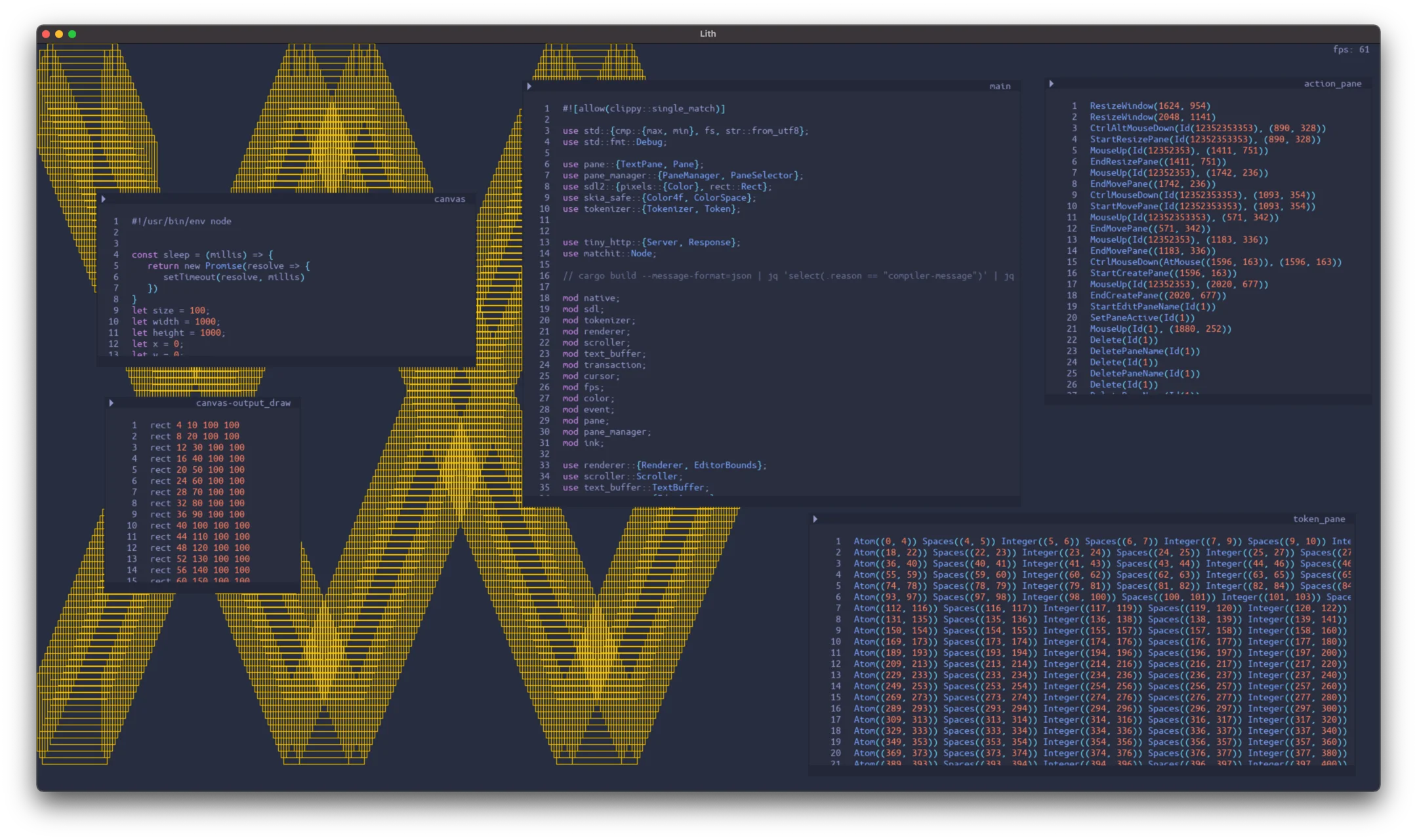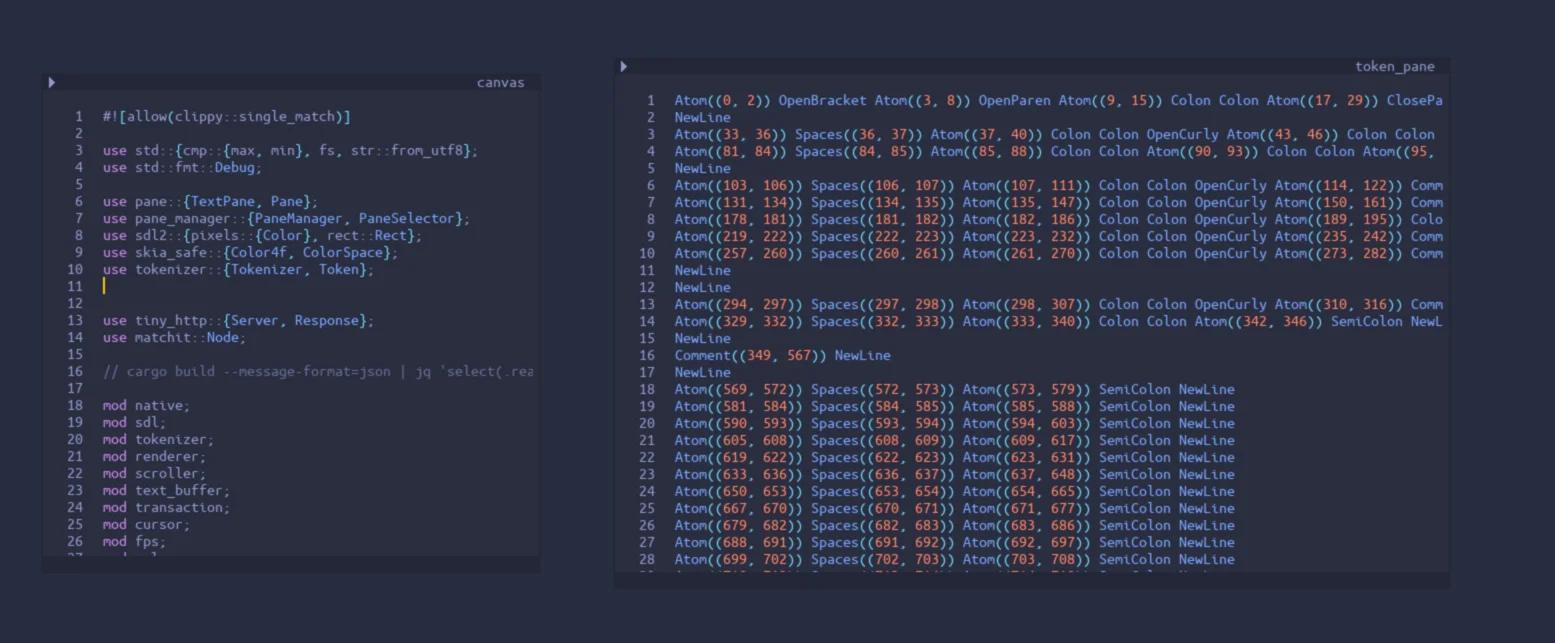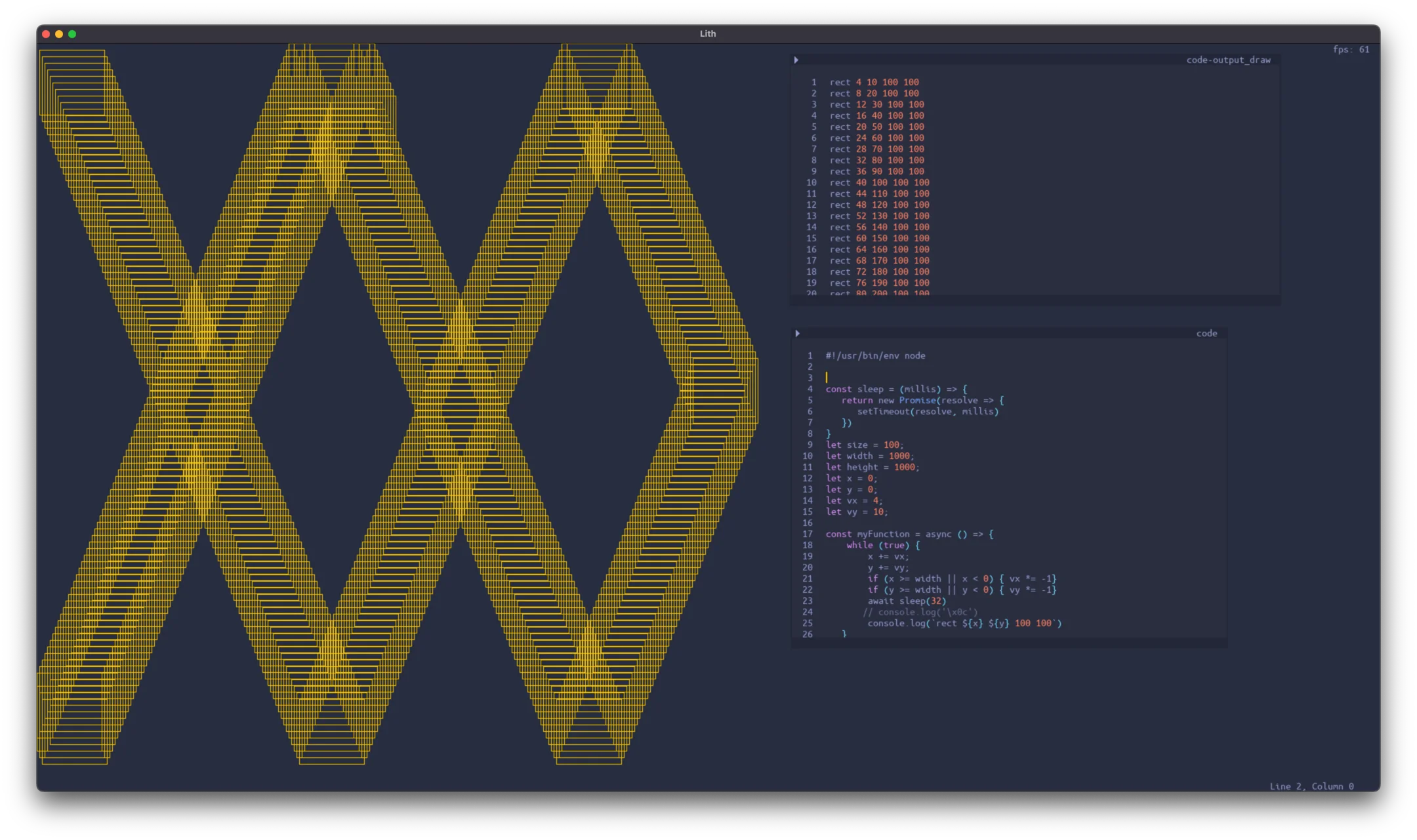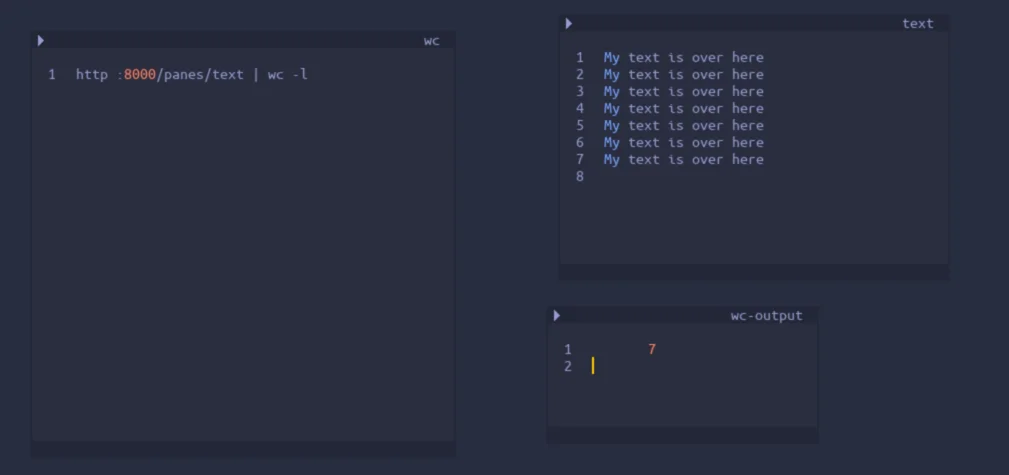

My Experience Building an Editor in Rust
source link: https://jimmyhmiller.github.io/editor-experience
Go to the source link to view the article. You can view the picture content, updated content and better typesetting reading experience. If the link is broken, please click the button below to view the snapshot at that time.
My Experience Building an Editor in Rust
I've always wanted to build a text editor. I've played around before with trying to modify existing editors like codemirror. But ultimately those just felt incredibly unsatisfying. While I was able to make some fun little experiments with them, I was just gluing code together. As I started to play with Rust, it seemed like the perfect opportunity to go beyond glue code. To write a GUI text editor from "scratch". Overall, I'd say it worked out pretty well. Here's a screenshot of where things are right now. (We'll explain what you see in a bit.)

The question of course is, what does "scratch". In my case, I decided that "scratch" was going to be defined as using sdl2 as my set of primitives. So I had a fairly high-level way of dealing with things like drawing to a screen and rendering fonts, but nothing text editor specific. This choice I think was pretty good for me to get stuff going. I have no experience with graphics APIs and had I started there, I might have just stayed there.
From the other angle, sdl2 was also good in that it didn't do too many things for me. There were no text edit widgets I was trying to control, no framework, just a library for windowing, drawing, font rendering, and eventing.
Background and Goals and Building
Before we talk about the general path I took, let's talk about my goals. Initially, my goal was to just build an editor. I wanted color syntax, I wanted general editing capabilities, that was about it. As time grew on, my goals became less and less clear. What I discovered as I kept developing is that building a text editor was a bit more finicky than I had expected, but also way easier than I ever imagined.
Rust is a really fast language. In my career, I've mostly worked in slow languages. I mostly worked on problems where speed was important, but not the most important. For this project I wanted performance. I use emacs to do my Clojure development and to be honest, it's terrible. I like paredit, I like my cider setup, but emacs freezes constantly. When I try to print data out in the repl, I can completely lock the editor. That wasn't something I'd allow my editor to do, so I thought I'd have to be super clever to make that happen. Turns out, I didn't.
Influences
Casey Muratori
As I was looking to undertake this project, Casey Muratori had put out his perhaps video about building a fast terminal. He walks through how he made the rendering fast by default using a standard technique called a font atlas. So that's where I started. If you like me had never heard of a font atlas, it is a simple idea. Draw a picture of all the characters you need and as you are rendering, you just reference those characters. No need to render the font each time.
In my case, I focused on ascii and just made a texture of all those characters. It was blazingly fast. Turning off vsync, I had 1000s of frames per second. I played around with manually adding some color and found that the performance held. Good sign. Now I had two things to figure out. 1) What data structure to use for editing. 2) How to do color syntax? Luckily for the first, there was some prior art that lead me down an unexpected path.
Jamie Brandon
After I started my project, I found out that Jamie had implemented a very similar idea but in zig. Because it was so similar though (used SDL, a font atlas, etc) I didn't want to look too closely at it and spoil the fun. But what I did do was read his blog posts on it and the one on text handling was particularly interesting. In the article, he says he just kept the text as a string and it was fast enough. Given my simplification of only handling ascii, I decided to try a Vec<u8> and it turns out, that was incredibly fast.
Modern computers are way faster than I think many of us realize. I was able to implement text editing operations just by using the Vec. When I insert text in the middle of a line, I insert it into the Vec, shifting the whole thing down. And yet, every file feels smooth. Didn't need to use a rope or any fancy data structure like that. Of course, those have other benefits, but in this case, I could keep focusing on my text editor.
Color Syntax
At this point, I had edit and display, but no color syntax. To figure out line breaks, I parsed the buffer and made a very inefficient line array of tuples with (start, end). I think this is one of those choices I wish I had done differently, mostly just on how I wrote the code, but it worked. One thing it let me do was only render the visible lines, so my first instinct for color syntax was to take advantage of that. I knew that editors like sublime use a regex-based solution that only looks a line at a time. So I thought, maybe I should just use that approach and take something off the shelf.
Failed Attempts
Syntect
I first looked at using Syntect for my highlighting. It works with sublime syntax files, so I'd be able to support many languages out of the box. It was incredibly easy to add to my project and well documented. I was able to integrate it very quickly and very quickly learn it was much too slow for what I wanted to do.
Now, this isn't to fault Syntect. The sublime syntax format is based on TextMate's format, which relies heavily on regex. Given the complexity and constraints of these formats, there is only so much you can do. But it wasn't cutting it for me. You see at this point in the project, I wanted to keep things as simple as possible. Syntect though would often completely miss the frame deadline. If I was in the middle of editing a file and needed to re-syntax-highlight it, it would kill the performance. So I had to look elsewhere.
Tree Sitter
Tree Sitter is a very interesting project out of Github. It does incremental parsing with really robust error handling of many languages. So, if I added tree-sitter to my editor, I should get syntax highlighting for cheap, but also, not have a performance issue as I'm editing. Or so I thought.
First getting tree-sitter setup was far from straightforward. The packaging and build situation for tree-sitter was a bit weird. But once I got that going, I was actually quite sad to find out that the highlighting portion of tree-sitter was not incremental at all. I looked for a little while at making my own custom integration and I knew it was possible, but also didn't sound like fun. So I took a different path building my own custom setup.
Tokenizing Every Frame
I started with the simplest possible thing I could do, make a custom tokenizer and tokenize on every single frame. So I did that, wrote a really terrible, representative tokenizer, and revamped my rendering to use it. Turns out, that was actually really fast and easy! Even with doing the incredibly naive thing of parsing every single frame, I was able to have the largest source files I could find on my machine open and editable in 60fps. Honestly, I was pretty blown away by how well that setup worked. Admittedly, my tokenizer is not very good now right. But as they say, that's just a matter of programming. I know that I can keep and even improve the performance while making it more feature-rich.
Moving Beyond the Traditional Editor
At this point, I had the basics and wanted to play. First question, since I'm a big fan of Muse, I thought what if my text editor was a canvas? Implementing that was very straightforward, if a bit finicky, and moved me directly into the more interesting things I now wanted to do.
Token Pane

As I was working on my tokenizer, I wanted to be able to see the output of the tokens right in the app. So I created what I called the token pane. If there is a pane called token_pane Its contents are defined as the raw tokens of the active pane. So now I could see exactly what things were tokenizing into. Incredibly useful for debugging.
Action Pane

Next was the action pane. Quite a bit trickier. Here I would display every action that happened in the app. But, what about scrolling the action pane? Well, if I did that, then as I scrolled the action pane would constantly get new actions. The whole thing was a bit of a mess.
The other hard part of this setup was that I originally didn't have a great way to refer to panes. My actions would be something like "MoveActivePane". But what was the active pane, or more precisely, when? Well, if I was looking at the actionpane, it was the active pane, so now as I'm filtering out actionpane actions, I would filter out all active pane actions! Not what I wanted. So I had to set up a system where your actions resolve to ids.
Draw Panes
Ultimately what I want out of an editor more than anything was captured in this early blog post on LightTable.. In it, they imagine an editor configurable in itself. But I wanted a different flavor. What if you could extend the editor in any language? I already had seen ways of seeing the internals of the editor and using panes as output. What if I could do the opposite, use panes as input? I later discovered a nice name for this, afterburner rendering ala Mary Rose Cook. Here's an example. What you can see here is some javascript that prints output like rect 4 10 100 100, that output is then parsed by the editor and drawn as rectangles to the screen.

Text Space Drawing
Obviously, rectangles aren't the most useful thing to draw. But I also played with rendering in text space. For example, here is a quick proof of concept of underlining text mentioned in rust compiler output. On the right, you see some unused imports. On the left, a quick bash script for drawing that to the screen.

The dream is that as things evolved, your editor could gain new powers simply by code you have running in panes. No need for an extension language. Simply output things to stdout and you can control and extend the editor. What I found with this experiment is that even with the most naive, unoptimized code doing things that way was entirely possible.
Accessing Pane Content
One fun experiment I played with was a way for any language to get the contents of a pane. Obviously, if a pane is backed by a file, you can read that file. But that wasn't good enough for me. I want you to be able to access the contents before changes have been saved. Further, you should be able to access it with just standard tools. So, I exposed the editor as an http service.

Honestly, as weird as it may seem, it was pretty easy to do, not expensive computationally, and made it easy to access the data. Ultimately, I'd love to even expose more things. Like being able to control the editor via http requests. Now, external programs can interact with the editor in a way I've never seen supported. Once we have that, it means we have the full Unix power accessible in our editor in a very first class way.
What Went Well
Rust was a wonderful language to write this in. I've gotten past the learning curve where I basically can write Rust without thinking too much about it. With all of these features, I was just thinking about the problems and not the language. While of course, Rust's ownership model pushed me in one direction, it never felt like it limited me.
One thing I really have grown to enjoy is rusts explicit clones. Without GC, clones can be expensive in a tight loop. Making them explicit lets me be able to easily spot my bottlenecks. Several times I could do a quick clone to get things working and then come back and move the code around to make the ownership clear and avoid the clone.
SDL2 was easy to get going on this project. From day one I had things drawing on the screen. The primitives SDL provides were just what I needed to focus on my task and not worry about the details.
My Willingness to Let the Code be Messy
I often get to a point in projects where things just stall out because I want to clean up my code and I don't know exactly how I want things to be. I know that the path I'm on is not the right one and instead of forging ahead with working code, I stop and consider, then lose interest and stop working on it. I didn't do that here. The codebase is a mess. There is a lot of duplicated code. And as it stands right now, things are broken from unfinished experiments. But, I got a lot done with this spare time project. And even with all the duplicated and poorly designed code, I only have 3442 lines of code.
What Went Poorly
My Messy Code
While my willingness to let the code get messy was definitely good. The actual messiness of the code did cause some quality issues. I never went back and changed my line parsing to take advantage of my tokenizing code. So I loop through each file twice per frame. Because I was doing things hacky from the beginning, it took me a while to get to the point where I could track changes and know if I need to do things like reparse a file. The code now has that ability, but hooking it up was a decent amount of work and I never did it.
Lack of Action Reification From the Beginning
I spent a lot of time refactoring code to emit data when an action happened. This is something I should have done from the beginning. As I was looking to implement undo/redo, this lack of reification and centralization of event handling led to all sorts of issues that still exist in the codebase.
Areas I'd love to Explore More
External Extensibility
I really had a blast making this. It went in entirely different directions than I expected. I think this idea of an editor extensible via its own pane contents is really interesting. Of course, emacs is perhaps the ultimate example of an extensible editor, but it is still via elisp. Admittedly, I am sure there are parts where keeping things external may become a bottleneck. If that became the case, it might be interesting to explore webassembly extension points. But what I would find more interesting is to try and continue down this path. Perhaps there is a nice binary format that makes these things not too slow. Could you for example implement a language server protocol library in the editor without it needing to be built in and without it needing to use an extension library?
Focusing on external extensibility also means that these extensions could be used by other editors. Basically, this work would expose an editor IR. An idea I find incredibly interesting and perhaps incredibly powerful.
Non-Traditional Layout
I never took my canvas idea very far. I didn't even implement panning around on the canvas. But I found myself loving these layouts. I did some code live in the editor for things like Conway's game of life, and being able to move my panes around and resize panes based on my focus were very nice interactions. I always have been a bit of a messy worker and I find having positions for things helps me out tremendously.
Conclusion
I had a blast doing this. Rust was a great language. I tried out lots of interesting ideas and they worked pretty darn well. But I think my biggest takeaway is that there is so much opportunity here. Text editors have largely remained unchanged in terms of user experience. Now with language servers, they can offer better static analysis and refactoring tools, but the ways of interacting with them have largely not changed.
There is so much potential here. Why haven't we explored new avenues for user interfaces in text editors? Why aren't there editors that let me work with them more flexibly? Is a column-based layout with some intellisense really the best there is? Will we never discover something better? In my view, there haven't been many serious attempts at this. Maybe there needs to be.
Recommend
About Joyk
Aggregate valuable and interesting links.
Joyk means Joy of geeK